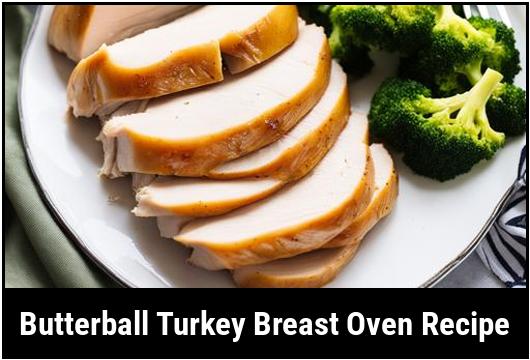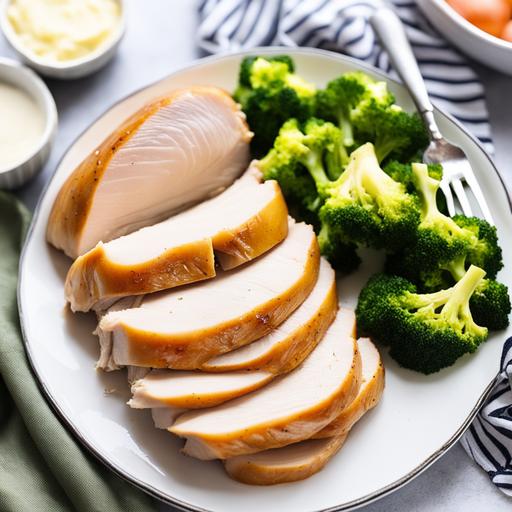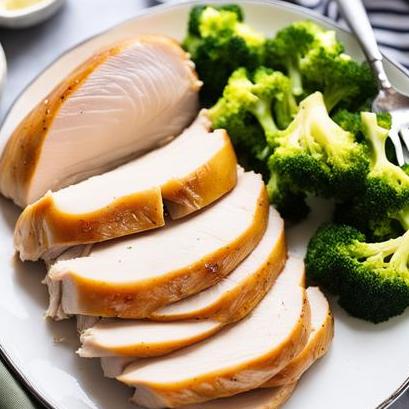
The Perfect Butterball Turkey Breast Oven Recipe: A Complete Guide For A Mouthwatering Feast
Welcome to the ultimate guide for preparing a succulent and flavorful Butterball turkey breast using your trusty oven. Whether you’re hosting a festive gathering, celebrating a special occasion, or simply craving a delicious and wholesome meal, this comprehensive article will walk you through every step of the process. Get ready to impress your family and friends with a mouthwatering centerpiece that will tantalize their taste buds and leave them longing for more. Let’s explore the culinary journey of a perfectly roasted Butterball turkey breast together!
The Science Behind a Juicy and Tender Turkey Breast
Understanding the science behind cooking meat is crucial to achieving a juicy, tender, and perfectly cooked turkey breast. When it comes to poultry, such as turkey, we often desire that delightful combination of a crisp and golden skin, while ensuring the inner meat remains moist, tender, and thoroughly cooked. To accomplish this, we must consider a few key factors.
1. Selection: Choosing the Perfect Butterball Turkey Breast
When selecting your Butterball turkey breast, it’s essential to choose one that is of the highest quality. Butterball turkeys are known for their premium quality, tenderness, and rich flavor, making them an excellent choice for any occasion. Look for a turkey breast that is plump, with a richly colored skin and firm texture. Additionally, check the packaging for any signs of damage or excessive ice crystals, as these can indicate improper storage or handling.
2. Cleaning: Preparing the Turkey Breast

Before we proceed with the culinary preparation, it’s essential to thoroughly clean the Butterball turkey breast. Rinse the turkey breast under cold running water, ensuring that all cavities are cleaned. Pat the turkey breast dry with paper towels, removing any excess moisture on the skin and inside the cavities. Clean your workspace and utensils meticulously to maintain optimal hygiene throughout the process.
3. Preparation: Seasoning and Flavoring the Turkey Breast
Seasoning plays a significant role in enhancing the flavors of your Butterball turkey breast. The possibilities are endless, but let’s explore a classic and delightful herb seasoning:
- Mix together a combination of dried herbs such as rosemary, thyme, sage, and parsley in a small bowl.
- Add some olive oil to create a paste-like consistency.
- Carefully loosen the skin of the turkey breast from the meat without tearing it, and gently spread the herb mixture over the meat under the skin.
- Rub the skin of the turkey breast with olive oil to promote browning and crispiness.
- Season the exterior generously with salt and pepper, ensuring an even distribution.
Remember, you are not limited to this specific herb mixture; feel free to experiment with different seasonings and flavors that complement your taste preferences.
4. Tips for a Perfectly Roasted Butterball Turkey Breast
To achieve a beautifully roasted Butterball turkey breast, consider the following tips:
- Preheat your oven to 325°F (163°C) to ensure consistent heat distribution and proper cooking.
- Use a roasting pan with a rack to elevate the turkey breast, allowing hot air to circulate evenly and promote even cooking.
- Baste the turkey breast occasionally during cooking to enhance moisture retention and boost flavor. You can use a baster or a brush to apply the juices from the bottom of the pan over the turkey breast.
- Tent the turkey breast with aluminum foil during the first ⅔ of the cooking time to prevent excessive browning and allow the meat to cook more evenly.
- Use a meat thermometer to monitor the internal temperature of the turkey breast. The optimal temperature for a perfectly cooked turkey breast is 165°F (74°C).
- Let the turkey breast rest for at least 15 minutes after removing it from the oven. This allows the juices to redistribute, resulting in a more tender and flavorful experience.
5. Variations: Exploring Flavorful Twists

While the classic Butterball turkey breast is undeniably delicious, don’t be afraid to add your own personal touch or experiment with flavor variations. Here are a few ideas to inspire your culinary creativity:
- Citrus Infusion: Add some zest to your turkey breast by incorporating the bright and refreshing flavors of citrus fruits. Squeeze fresh lemon or orange juice over the turkey breast before seasoning, or even stuff the cavity with slices of citrus for extra aromatic delight.
- Savory Herb Butter: Elevate the buttery goodness by combining softened butter with a medley of fresh herbs, such as thyme, rosemary, and garlic. Spread this herb-infused butter under the turkey breast skin before roasting for a burst of aromatic flavors.
- Sweet Maple Glaze: For those with a penchant for sweet and savory combinations, consider preparing a maple glaze to brush onto the turkey breast during the final stages of cooking. The subtle sweetness will perfectly complement the savory notes of the turkey, creating a harmonious symphony of flavors.
Remember, cooking allows for personal expression and creativity, so feel free to explore and adapt these ideas to match your taste preferences and create a stunning culinary masterpiece!
6. Ensuring Doneness: Checking for Perfect Cooking Results
Determining the doneness of your Butterball turkey breast is essential to avoid undercooking or overcooking the meat. One of the most reliable and accurate methods is using a meat thermometer. Insert the thermometer into the thickest part of the breast, taking care not to touch bone, as this could give an inaccurate reading. When the internal temperature reaches 165°F (74°C), your turkey breast is perfectly cooked and ready to be removed from the oven.
If you don’t have a meat thermometer, visually assessing the cooking results can be helpful. The skin should be golden brown, and the juices should run clear when the turkey breast is pierced with a fork at the thickest part. Additionally, the meat should be firm to the touch, indicating that it is fully cooked.
7. Overcook or Undercook: Dealing with Potential Mishaps
Sometimes, despite our best efforts, accidents happen in the kitchen. If you find yourself with an overcooked or undercooked Butterball turkey breast, don’t despair! Here are some handy tips to salvage the situation:
- Overcooked Turkey Breast: If the turkey breast is slightly overcooked, you can still enjoy a succulent meal by counteracting the dryness. Slice the breast thinly and serve it with a luscious sauce or gravy that adds moisture and restores tenderness. Additionally, consider serving the turkey breast alongside flavorful side dishes and gravies to enhance the overall enjoyment.
- Undercooked Turkey Breast: Discovering an undercooked turkey breast can be disheartening, but there’s a solution! Return the turkey breast to the oven, and continue cooking at a lower temperature until it reaches the desired temperature of 165°F (74°C). Remember to tent it with aluminum foil to prevent excessive browning.
8. The Butterball Turkey Breast Oven Recipe
Without further ado, let’s dive into the step-by-step recipe for a perfectly roasted Butterball turkey breast:
Ingredients:
- 1 Butterball turkey breast (size of your choice)
- Dried herbs (rosemary, thyme, sage, parsley)
- Olive oil
- Salt and pepper to taste
Instructions:
- Preheat your oven to 325°F (163°C).
- Rinse the turkey breast under cold running water, ensuring all cavities are cleaned. Pat dry with paper towels.
- In a small bowl, mix together the dried herbs and olive oil to create a paste-like consistency.
- Carefully loosen the skin of the turkey breast without tearing it. Gently spread the herb mixture over the meat under the skin.
- Rub the skin of the turkey breast with olive oil.
- Season the exterior generously with salt and pepper, ensuring an even distribution.
- Place the turkey breast on a roasting rack in a pan.
- Roast in the preheated oven for the recommended time based on the size of your turkey breast, following the Butterball packaging guidelines or referring to a reputable source.
- Baste the turkey breast occasionally during cooking.
- Tent the turkey breast with aluminum foil during the first ⅔ of the cooking time.
- Check for the internal temperature using a meat thermometer. Once it reaches 165°F (74°C), remove the turkey breast from the oven.
- Let the turkey breast rest for at least 15 minutes.
- Carve and serve alongside various side dishes of your choice.
9. Feast Time: Serving and Enjoying the Perfectly Roasted Butterball Turkey Breast
Finally, it’s time to savor the fruits of your labor and delight in the delectable flavors of your perfectly roasted Butterball turkey breast! Carve the turkey breast into thin slices, revealing the juicy, tender meat concealed beneath the flavorful skin. Pair it with a range of side dishes, such as cranberry sauce, roasted vegetables, creamy mashed potatoes, or soft dinner rolls.
Gather your loved ones around the dining table and embark upon a culinary journey filled with warmth, joy, and unforgettable memories. Share stories, laughter, and gratitude as you savor every mouthful of the succulent Butterball turkey breast you have masterfully created.
Now, armed with a deep understanding of the food science, culinary details, selection, cleaning, preparation, tips, variations, doneness checks, and a sumptuous recipe, you are well-equipped to embark on your journey to roast the perfect Butterball turkey breast. May your culinary endeavors be filled with immense pleasure, and may your feasts always be met with appreciation and delight. Happy cooking and bon appétit!
Sources
FAQS On Butterball Turkey Breast Oven Recipe
What Size Turkey Breast Should I Buy For The Oven Recipe?
For an oven recipe, we recommend a boneless turkey breast that weighs between 3-4 pounds.
Can I Use A Frozen Turkey Breast For The Oven Recipe?
It is not recommended to use a frozen turkey breast for the oven recipe, as it will take longer to cook and may result in an unevenly cooked turkey.
How Long Should I Cook The Turkey Breast In The Oven?
Preheat your oven to 350°F and cook the turkey breast for approximately 20 minutes per pound. The internal temperature should reach 165°F before serving.
Is It Necessary To Baste The Turkey Breast While It’s Cooking In The Oven?
Basting is not necessary, but it can help keep the meat moist. If you choose to baste, do so every 30 minutes during the cooking process.
Can I Stuff The Turkey Breast Before Cooking In The Oven?
No, it is not recommended to stuff a turkey breast before cooking it in the oven. This can increase the cooking time and may result in an undercooked or overcooked turkey breast.



